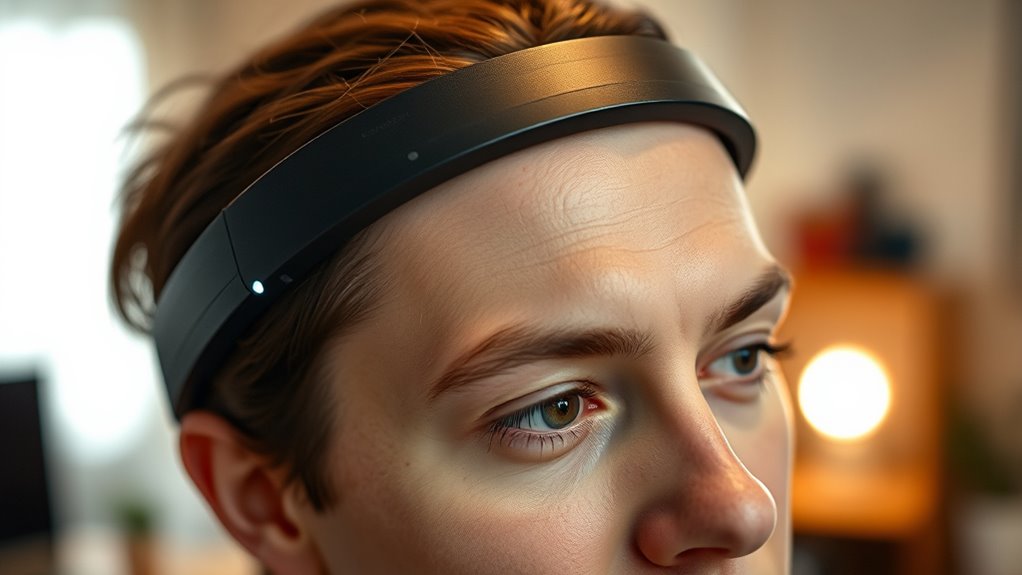Brain-sensing headbands can boost your focus, reduce stress, and support mindfulness, making them helpful tools for mental well-being. However, they may also distract if the feedback isn’t accurate or if you rely on them too much. Technical glitches and unreliable data could lead to misinterpretation of your mental states. To discover how these devices can serve you—and what to watch out for—you’ll find valuable insights ahead.
Key Takeaways
- Brain-sensing headbands can enhance focus and relaxation, making them helpful tools for mental well-being.
- They provide real-time feedback, which may improve self-awareness but can also lead to distraction if misinterpreted.
- Technical inaccuracies or inconsistent data might reduce their usefulness, sometimes causing users to become overly focused on device readings.
- Advances in AI and neural algorithms are increasing their effectiveness, supporting more seamless and integrated user experiences.
- Proper use and realistic expectations are essential to prevent headbands from becoming a distraction rather than a helpful aid.
How Brain-Sensing Headbands Work
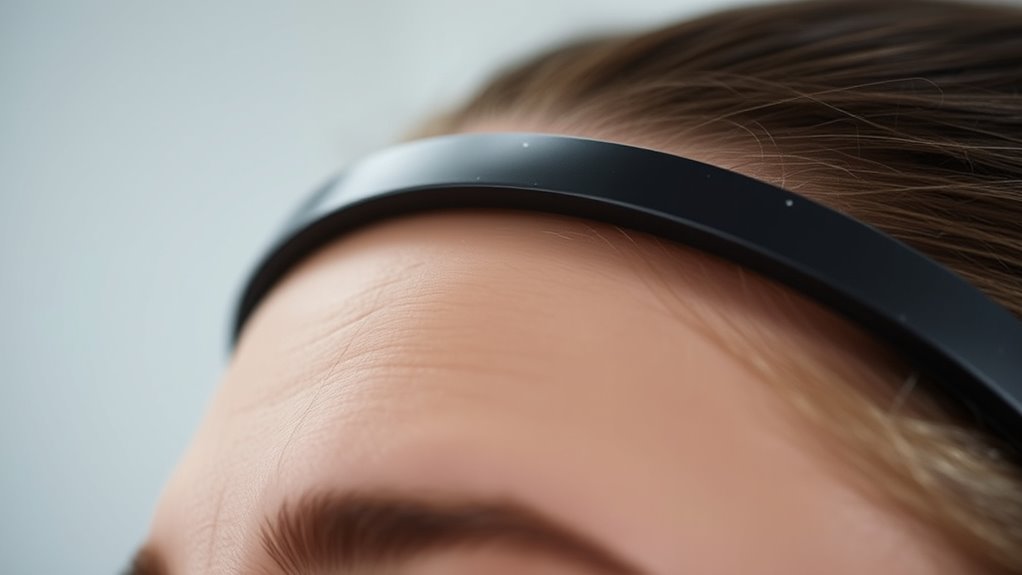
Brain-sensing headbands work by detecting electrical signals produced by your brain, known as brainwaves. These devices use advanced sensor technology to pick up the tiny electrical impulses generated by neuron activity. When you wear a headband, sensors are positioned against your scalp, capturing brainwave patterns in real time. These patterns vary depending on your mental state, such as focus, relaxation, or alertness. The headband then processes this data, translating electrical signals into readable information. This technology relies on electrodes embedded in the headband, which detect the electrical activity with high sensitivity. By accurately analyzing brainwave patterns, the device provides insights into your mental state, laying the groundwork for applications like meditation, focus training, or mood monitoring. Additionally, high-precision sensors enhance the accuracy of data collection, making these headbands more effective for various cognitive assessments.
Potential Benefits for Mental Well-Being
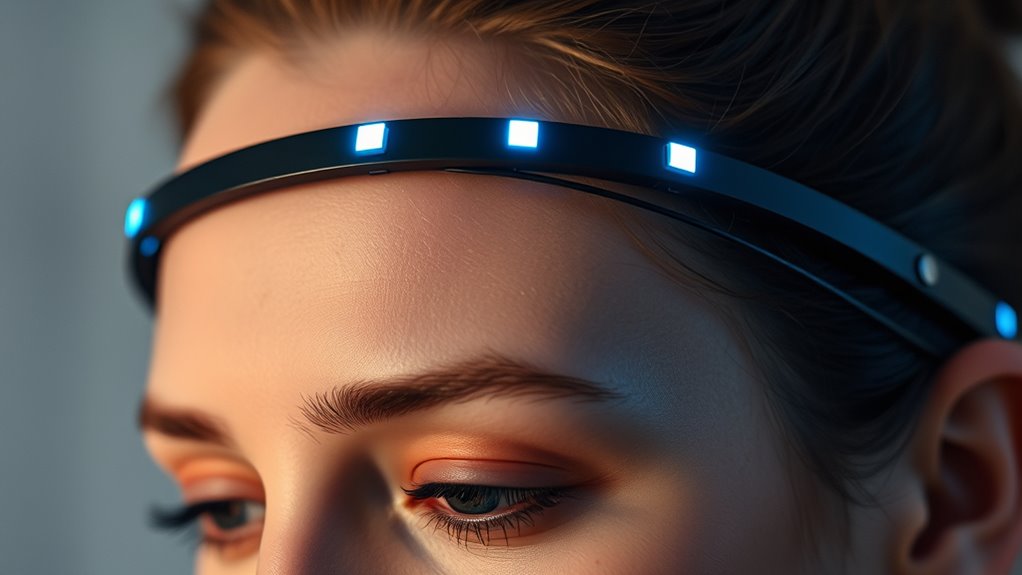
Brain-sensing headbands can help you improve your focus and stay present throughout your day. They also promote stress reduction by guiding you into relaxation techniques. By using these devices, you may experience a clearer mind and a calmer state of being. Additionally, they can support mindfulness and meditation practices, which are linked to enhanced mental health and emotional regulation meditation.
Enhanced Focus and Concentration
When your focus improves, it becomes easier to stay engaged and productive throughout the day. Brain-sensing headbands can support this by providing real-time feedback, helping you practice mindfulness training more effectively. As you learn to monitor your brain activity, you’ll develop better control over your attention, leading to enhanced focus. This targeted approach promotes cognitive enhancement, allowing you to stay on task longer and reduce distractions. Consistent use can strengthen your mental clarity and concentration, making daily activities feel more manageable. With clearer focus, you may notice improvements in learning, problem-solving, and decision-making. These headbands serve as tools to sharpen your mental skills, boosting your overall ability to concentrate and stay attentive in various settings. Additionally, understanding the underlying principles of sound design can help in creating more effective auditory feedback that enhances mental training experiences.
Stress Reduction and Relaxation
As you learn to better control your attention with headbands, you can also experience notable benefits for stress reduction and relaxation. These devices help you monitor your brain activity, making mindfulness meditation and stress management techniques more effective. By providing real-time feedback, headbands encourage you to stay present and calm. Here are three ways they support relaxation:
- Promote mindfulness meditation by guiding you to focus on your breath or sensations.
- Help identify stress triggers through brainwave patterns, enabling better stress management.
- Reinforce relaxation habits with consistent practice, reducing overall anxiety.
- Awareness of brain activity can empower you to make informed adjustments to your stress relief strategies.
Using brain-sensing headbands can make relaxation exercises more engaging and personalized, ultimately improving your mental well-being and resilience against daily stressors.
Common Concerns and Limitations
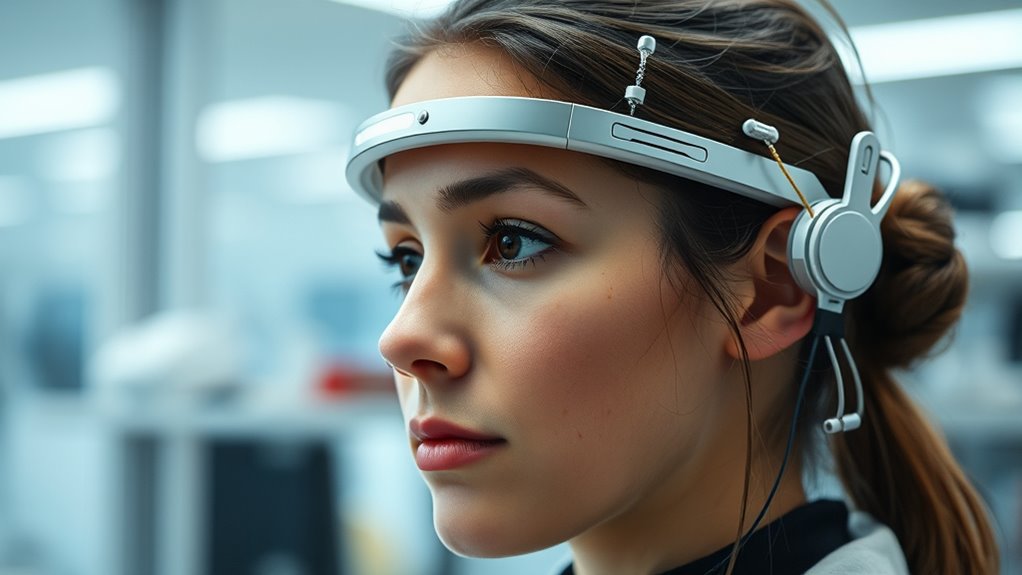
Despite their innovative potential, brain-sensing headbands face several concerns and limitations that you should be aware of. Many products overhype their promises, claiming to deliver instant mental clarity or profound emotional change, which can lead to disappointment. Additionally, technical inaccuracies often plague these devices; sensors may not always accurately detect brain activity, resulting in unreliable feedback. This can cause you to misinterpret your mental state or become frustrated with inconsistent results. Moreover, some headbands lack standardized validation, making it hard to trust their effectiveness. While they may provide helpful insights, it’s important to approach these tools critically, understanding their current limitations and avoiding reliance on exaggerated claims that can undermine your expectations. Furthermore, the accuracy of brain-sensing technology is affected by factors such as sensor placement and individual differences, which can further impact reliability.
The Science Behind Neurofeedback Devices

Neurofeedback devices work by measuring your brain’s electrical activity and providing real-time feedback to help you learn to regulate it. They analyze brainwave patterns to identify specific states like focus or relaxation. During a session, the device calibration process ensures accurate readings, which is vital for effective training. Here’s what happens behind the scenes:
- Sensors detect electrical signals from your scalp, capturing brainwave data.
- The device analyzes your brainwave patterns to determine your mental state.
- Real-time feedback guides you to modify your brain activity, reinforcing desired patterns.
This cycle helps you build awareness of your brain activity and gradually learn to control it. The science relies on understanding how brainwave patterns can be influenced and optimized through targeted feedback.
User Experiences and Testimonials
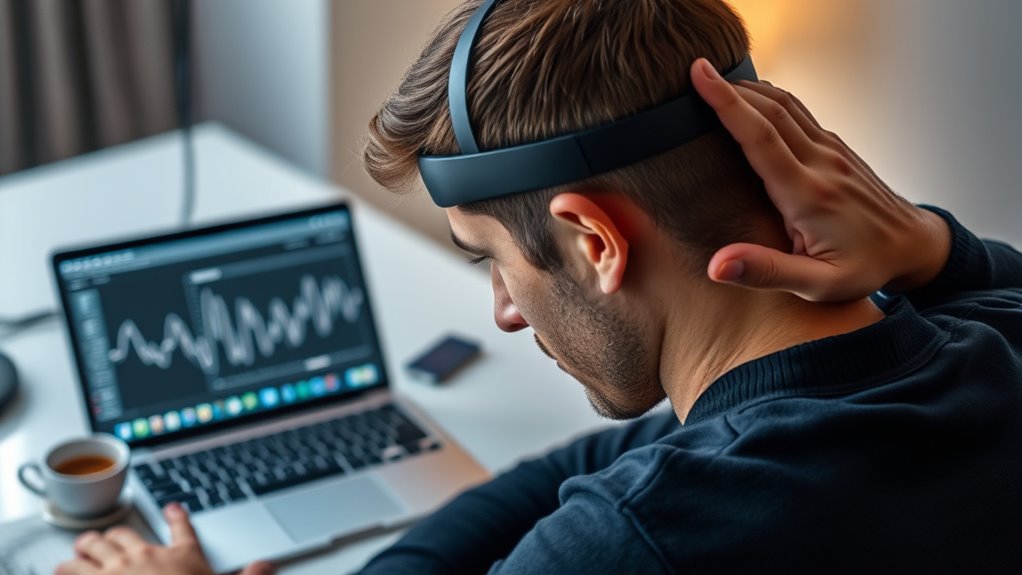
Have you ever wondered what it’s like to experience the benefits of brain-sensing headbands firsthand? Many users report high satisfaction, praising how intuitive and easy the device feels during use. They often mention that the device usability is straightforward, even for those new to neurofeedback technology. Users appreciate how quickly they can set it up and start tracking their brain activity without hassle. Testimonials highlight improvements in focus, relaxation, and stress reduction, which boost confidence in these devices. However, some mention occasional discomfort or technical glitches that can affect overall user satisfaction. Additionally, understanding Glycolic Acid benefits for skin can help users make informed choices about skincare routines that complement their mental wellness practices. Overall, most users find brain-sensing headbands helpful, feeling motivated to incorporate them into daily routines, making the experience both rewarding and engaging.
Ethical and Privacy Considerations
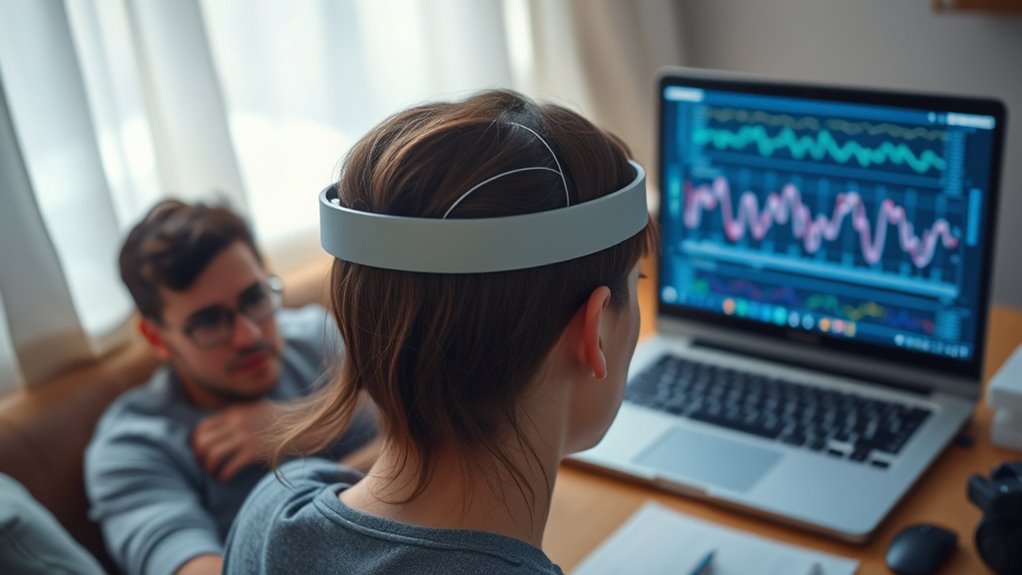
As users embrace the benefits of brain-sensing headbands, it’s important to contemplate the ethical and privacy implications that come with collecting sensitive neural data. You should be aware of how data privacy is preserved and ensure that informed consent is given freely. Additionally, understanding privacy safeguards implemented by manufacturers can help protect your neural information from potential misuse.
Future Trends and Developments

Looking ahead, the future of brain-sensing headbands promises exciting advancements driven by technological innovation and growing demand. AI integration will play a bigger role, enabling headbands to analyze your brain signals more accurately and deliver personalized feedback. Expect wearable technology to become more seamless, lightweight, and comfortable, making it easier for you to use these devices daily. Developers are working on smarter algorithms that adapt to your unique neural patterns, improving applications in mental health, focus, and learning. As these innovations evolve, brain-sensing headbands will likely become essential tools for wellness, productivity, and even entertainment. The combination of AI and wearable technology will open new possibilities, making these devices more intuitive and impactful in your everyday life. Additionally, advancements in neural network algorithms will enhance the headbands’ ability to process complex brain data more efficiently.
Frequently Asked Questions
Are Brain-Sensing Headbands Suitable for Children or Teenagers?
When considering if brain-sensing headbands are suitable for children or teenagers, you should prioritize child safety and ethical considerations. These devices can offer benefits like improved focus, but they also raise concerns about data privacy and consent. You need to weigh the potential advantages against risks, ensuring proper supervision and clear understanding of how the data is used. Ultimately, consult professionals to make an informed decision for your child’s wellbeing.
How Long Does It Take to See Noticeable Results?
You might worry about how long it takes to see results from a brain-sensing headband, but don’t let that hold you back. With consistent use and a manageable learning curve, you could notice improvements in focus or relaxation within a few weeks. Staying dedicated and practicing regularly helps your brain adapt faster, making the benefits more noticeable sooner. Patience and user consistency are key to revealing the headband’s full potential.
Can These Devices Replace Professional Mental Health Treatments?
You might wonder if these devices can replace professional mental health treatments. While they offer insights and support, ethical implications and data privacy are concerns you should contemplate. These headbands shouldn’t substitute trained therapists, as they lack personalized care. Always prioritize consulting mental health professionals for serious issues. Using these devices responsibly, with awareness of privacy risks, ensures you benefit without risking your confidentiality or relying solely on technology.
What Are the Costs Involved in Purchasing and Maintaining Them?
Think of buying brain-sensing headbands as planting a seed—you’ll face initial costs and ongoing maintenance expenses. A thorough cost analysis reveals prices range from $200 to over $500, depending on features. Maintenance expenses include replacing sensors, app subscriptions, or calibration. While this investment may seem steep, understanding these costs helps you decide if their benefits outweigh the financial commitment, ensuring you’re not caught off guard by hidden expenses.
Do Headbands Cause Any Long-Term Negative Effects?
You might wonder about the long-term effects and potential risks of using brain-sensing headbands. Currently, there’s limited evidence showing significant long-term negative effects, but some users report headaches or discomfort with extended use. It’s wise to monitor how you feel over time and consult a healthcare professional if you notice persistent issues. Being cautious helps minimize potential risks while enjoying the benefits these devices might offer.
Conclusion
As you explore brain-sensing headbands, remember that about 80% of users report improved focus and relaxation. While they can boost mental well-being, be cautious of potential distractions and privacy concerns. Stay informed about the latest developments to make the most of these devices. Ultimately, blending technology with mindful practices can help you access your brain’s potential—just make certain you use these tools wisely and ethically.
